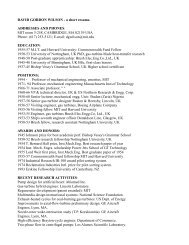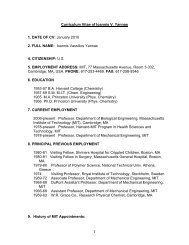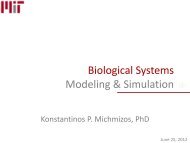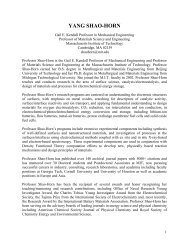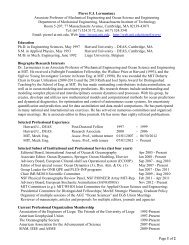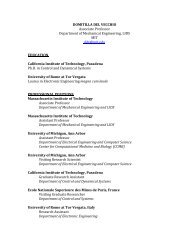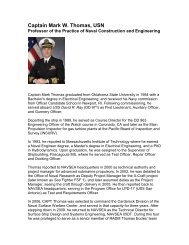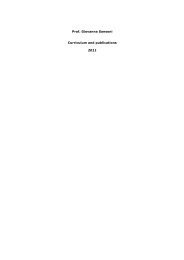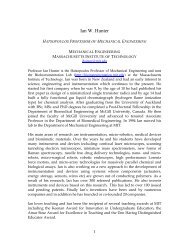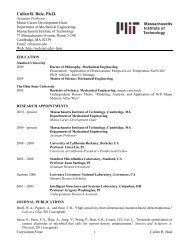Compound Noise - MIT Department of Mechanical Engineering
Compound Noise - MIT Department of Mechanical Engineering
Compound Noise - MIT Department of Mechanical Engineering
Create successful ePaper yourself
Turn your PDF publications into a flip-book with our unique Google optimized e-Paper software.
392 J. SINGH ET AL.<br />
System<br />
Table II. Results from resolution III control and noise factor array<br />
Hierarchy<br />
Measure<br />
<strong>of</strong> sparsity<br />
<strong>of</strong> effects<br />
Number <strong>of</strong><br />
replications<br />
Matching <strong>of</strong><br />
all control<br />
factors with<br />
their robust<br />
setting<br />
(%)<br />
Matching <strong>of</strong><br />
control factors<br />
with their<br />
robust setting<br />
(%)<br />
Improvement<br />
ratio<br />
(%)<br />
Op Amp Strong 0.105 100 98 99.6 99.91<br />
CSTR Weak 0.647 100 None 76.5 96.5<br />
Temperature Weak 0.725 100 28 55 87<br />
control circuit<br />
Slider crank Weak 0.119 100 91 95.5 97.6<br />
System<br />
Table III. Results from resolution III control factor array and two-level compound noise<br />
Hierarchy<br />
Measure <strong>of</strong><br />
sparsity <strong>of</strong><br />
effects<br />
Number <strong>of</strong><br />
replications<br />
Matching <strong>of</strong><br />
all control<br />
factors with<br />
their robust<br />
setting<br />
(%)<br />
Matching <strong>of</strong><br />
control factors<br />
with their<br />
robust setting<br />
(%)<br />
Improvement<br />
ratio<br />
(%)<br />
Improvement<br />
ratio (from<br />
resolution III<br />
noise array)<br />
(%)<br />
Op Amp Strong 0.105 100 86 97.2 99.37 99.91<br />
CSTR Weak 0.647 100 None 41.17 39.8 96.5<br />
Temperature Weak 0.725 100 None 43.5 25.2 87<br />
control circuit<br />
Slider crank Weak 0.119 100 89 94 96.5 97.6<br />
System<br />
Table IV. Average results from full factorial control factor array and two-level random compound noise<br />
Hierarchy<br />
Measure <strong>of</strong><br />
sparsity <strong>of</strong><br />
effects<br />
Number <strong>of</strong><br />
replications<br />
Matching <strong>of</strong><br />
all control<br />
factors with<br />
their robust<br />
setting<br />
(%)<br />
Matching <strong>of</strong><br />
control factors<br />
with their<br />
robust setting<br />
(%)<br />
Improvement<br />
ratio<br />
(%)<br />
Improvement<br />
ratio (from<br />
Taguchi’s<br />
compound<br />
noise)<br />
(%)<br />
Op Amp Strong 0.105 1000 30.8 73 80.2 99.2<br />
PNM Strong 0.132 2 4 = 16 50 68.75 79.9 99.5<br />
Journal bearing Strong 0.28 2 3 = 8 100 100 100 98.84<br />
CSTR Weak 0.647 2 6 = 64 54.69 70.3 67.6 58.4<br />
Temperature Weak 0.725 2 5 = 32 68.75 76.56 74.75 30.65<br />
control circuit<br />
Slider crank Weak 0.119 2 5 = 32 50 70 55.2 98.5<br />
The compound noise strategy also does not perform well with a resolution III control factor array for the<br />
temperature control circuit. The improvement ratio drops from 87% for a resolution III noise array to 25%<br />
for two-level compound noise.<br />
In the formulation <strong>of</strong> compound noise as suggested by Taguchi 1 and Phadke 3 , we need to know the<br />
directionality <strong>of</strong> noise factors on the system’s response. We need to run some fractional factorial experiments<br />
on the system to gather information about the directionality <strong>of</strong> noise factors. We tried a different formulation<br />
Copyright c○ 2006 John Wiley & Sons, Ltd. Qual. Reliab. Engng. Int. 2007; 23:387–398<br />
DOI: 10.1002/qre



